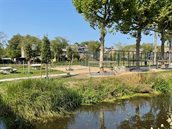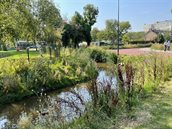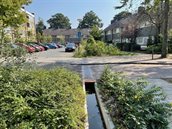City of Leiden links climate adaptation and biodiversity to maintenance plans in Gasthuiswijk neighbourhood
The city of Leiden is tackling entire neighbourhoods in one go, combining the redevelopment of public space with tasks in the fields of climate adaptation and biodiversity. Good results are being achieved by linking the tasks to maintenance plans for the sewer system and public space. One of the neighbourhoods renovated in Leiden is the Gasthuiswijk neighbourhood. The sections below set out the measures implemented by the municipality to climate-proof this neighbourhood.
More room for water
A new water structure was excavated for the Gasthuiswijk and Haagweg Zuid neighbourhoods, in order to be able to collect more rainwater. The new water system consists of a separate sewer system and a central peak water storage in the neighbourhood. The municipality can raise the water level of the new water structure in order to cope with heavy rainfall. In addition, sections of the stretches of grass in the neighbourhood were converted into ditches, which connect to the central peak water storage. Furthermore, several bioswales were constructed in the neighbourhood, whilst newly laid water-permeable pavements allow rainwater to drain directly into the soil.

Nature-friendly embankments and smart discharge system
The embankments along the water have been designed in a nature-friendly manner. This creates new habitats for various plant and wildlife species. A smart discharge system ensures regular water replacement, enables rainwater collection and protects the neighbourhood against dehydration and midge issues during summer.

Design drawn up by the entire construction team
The design was drawn up in a construction team framework, which is a type of contract involving collaboration between the Municipality of Leiden and G. Van der Ven B.V. contractors, Wurck landscape architect, Beaumont communication agency and Tauw engineers. This type of contract enabled the municipality to capitalise on private sector knowledge in order to develop an innovative and broadly supported design. Another advantage of this type of contract is that it enables the contractor to calculate the costs directly. Thus, during the design process, the team was able to make design choices based on a cost estimate. As the contractor had joined at an early stage, the team could immediately harness their practical implementation know-how in the design process. Tauw engineers calculated and elaborated the financial consequences of the designed adaptation measures. The participation and communication strategies were developed and elaborated by Beaumont communication agency.
Managing authorities play a key part
The Municipality of Leiden aligns the maintenance schedules for the sewer system and public space. The managing authorities play a key part in the review of these schedules. Efficient scheduling enables the entire neighbourhood to be tackled in one go when replacing the sewer system, rather than working on a street-by-street basis. This not only saves costs, but also opens up possibilities for incorporating climate adaptation and biodiversity into the design.

Lessons to be learned
- At the start of the project, a policy framework for climate adaptation had not yet been set down. Consequently, during the design stage, the municipality had to develop prerequisites and solutions step by step. This necessitated a fair bit of exploring: what is climate adaptation, and how do you go about it?
- In every neighbourhood renovation project, the municipality picks up useful information for the next project. For example, initially, only sections of the Noorderkwartier Oost neighbourhood were surfaced with water-permeable pavement. At that time, the municipality was not ready to provide the entire neighbourhood with such pavement. However, in the Gasthuiswijk neighbourhood, it has tried out various patterns using existing tiles, with room between them to allow water drainage. It is a matter of learning what you can use and how you can best apply the know-how.
- A practical and communicative attitude is essential with this type of project. It requires continuous review and consultation on what works and what does not work.
Contact person
Jolanda de Schiffart
Gemeente Leiden
j.de.schiffart@leid